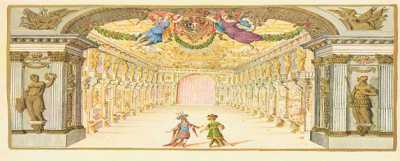An International Interdisciplinary Symposium
7 August 2010 Venue: King’s College, Strand, London
The Italian styles in entertainment had begun to seep northwards in the early sixteenth century, when Italians and more specifically Milanese dancing masters travelled to France and brought with them all the Italian figured dances.
The ballet Comique de la Reine Luise (1581) is the first example of the ballet de cour tradition and was masterminded by an Italian choreographer and violinist Balthazar de Beaujoyeulx and the queen Caterina de Medici. The fashion of ballet de cour spread across Europe. The ballets created during the period of High Renaissance are undoubtedly among the major masterpieces of the theatrical genre of the era, and this can be proved not only in terms of their popularity, but also of the high quality, craftsmanship and their variety in form. Emphasizing this diversity, the conference focuses on the interplay and tensions between discourses, continuities and discontinuities, and competing images of the seventeenth century ballet in Europe.
Possible topics include:
- Seventeenth century ballet music
- The role of dance in early opera and Intermedii
- Ballet as a propaganda tool in seventeenth century Italy
- Choreography
- Iconography and stage design in seventeenth century ballet
- Ballet and exoticism
- Ballet and Neo-platonism
A selection of papers will be published.
Call for papers: 1 March 2010
For information please contact Barbara Grammeniati (bgrammeniati@msn.com)

Comments
Seventeenth century ballet:
Seventeenth century ballet: a multi-art spectacle
An International Interdisciplinary Symposium
Date: 7 August 2010
Venue: King’s College, Strand, London WC2R 2LS
9:00-9:30 Registration/Coffee
9:30-12:00 Italian Ballet (Chair: Prof. Ronnie Mulryne)
Professor Iain Fenlon (Cambridge)
Maria Magdalena of Austria and the Uses of Danced Spectacle
Professor Anthony M. Cummings (Lafayette College)
Dance and the ‘Other’: the Moresca
Cecilia Nocilli (Universidad de Valladolid)
The Art of the Dance in the Early Italian Seventeenth Century: Prima or Seconda Prattica?
Jennifer Nevile (School of English, Media and Performing Arts)
Choreography and Meaning in Seventeenth-Century Danced Spectacles
Barbara Grammeniati (Roehampton)
Filippo d’Agliè’s ballet “Il Gridelino”
12:00-12:30 Lunch
12:30-14:00 French Ballet (Chair: Prof. Margaret McGowan)
Professor Judi Loach (Cardiff University)
Menestrier’s Des Ballets Anciens et Modernes: The theoretical underpinnings of the first published theory of ballet.
Lionel Sawkins
Dance, Spectacle and Divertissement in Lully’s "Isis" (1677)
Klaus Abromeit
Let’s dance the “Balli die Sfessania”
Kimiko Okamoto
“Passacaille of Armide”: Rhetorical Aspects of the tragédie en musique
14:00-14:30 Coffee
14:30-6:00 European Ballet (Chair: Margaret Shewring)
Gerite Berenike Heiter
Court Ballet in France and Austria in the First Half of the 17th Century: A Comparative Study.
Anne Daye (Laban)
The masque as political tool: Tethys’ Festival June 5 1610
Jane Gingel
The Swedish Court Ballet: Feminist, Pacifist and Environmentalist
Elizabeth Dyer (University of York)
Ballet de Cour in Seventeenth-Century Belgian Augustinian College Theatre
Uta Dorothea Sauer (Technische Universität Dresden)
Genesis of the “Ballettoper” at the Court of Dresden (Saxony)
Stefano Fogelberg Rota (Università Maria Santissima Assunta)
War and peace in the court ballets performed during the reign of Queen Christina of Sweden (1644-1654)